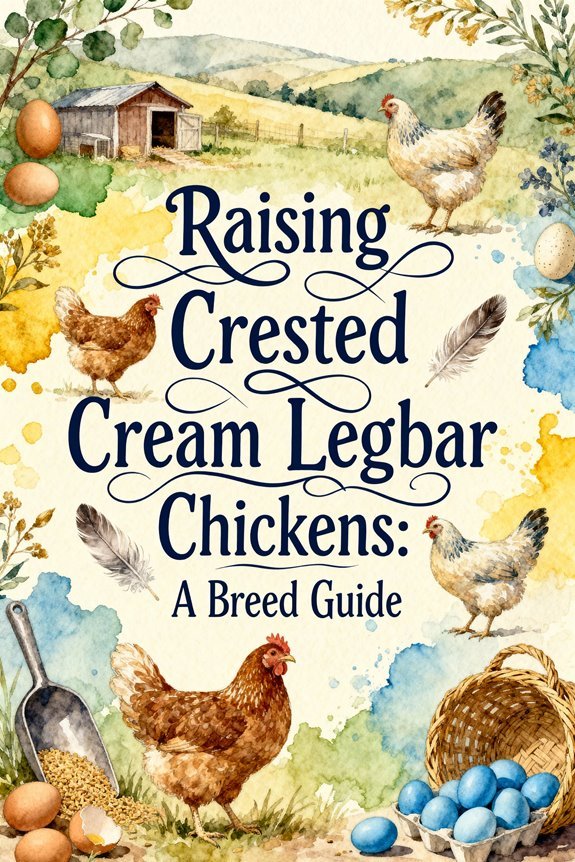Raising Crested Cream Legbar Chickens: A Breed Guide
You’ll find Crested Cream Legbars to be auto-sexing birds that lay distinctive blue eggs, developed through selective breeding at Cambridge University in the 1930s. These docile chickens feature silver-grey plumage in hens and cream barring in roosters, with both sexes displaying characteristic crown-like crests. They’ll produce 150-200 eggs annually, starting at 5-6 months old, and thrive with 10 square feet of outdoor space per bird. Their unique genetic heritage offers fascinating insights into specialized poultry breeding.
The History and Origins of Crested Cream Legbars
While many heritage chicken breeds have uncertain origins, the Crested Cream Legbar‘s development is precisely documented through the work of Reginald Crundall Punnett and Michael Pease at Cambridge University’s Genetical Institute in the 1930s. The genetic development involved crossing blue-egg-laying South American birds with Golden Penciled Hamburgs and various Leghorn varieties to create an auto-sexing breed.
The breed’s careful cultivation introduced the dilute cream gene and distinctive crest from Araucana lineage. After its presentation at the 1947 London Dairy Show, the Crested Cream Legbar achieved breed recognition from the Poultry Club of Great Britain in 1958. Though nearly extinct in the 1970s, the breed’s unique blue-egg laying capability and auto-sexing traits guaranteed its survival through dedicated preservation efforts. The breed’s development was initiated when Professor Punnett acquired Chilean blue-egg hens from Clarence Elliott in 1929.
Physical Characteristics and Breed Standards
As a breed developed through precise genetic selection, the Crested Cream Legbar exhibits distinct physical characteristics that make it easily identifiable among other chicken breeds. You’ll notice the striking feather coloration differs between sexes, with females displaying silver-grey bodies with broad barring and salmon-colored breasts, while males showcase cream coloring with dark grey barring. This auto-sexing trait makes gender identification straightforward from hatching. Owners appreciate their docile temperament, making them an excellent choice for backyard flocks.
The breed’s distinctive features include a single bright red comb and matching wattles, complemented by a triangular face and straight beak. Females sport a small crown-like crest, while males display prominent hackle feathers. Their streamlined bodies typically weigh 2.7-3.4 kg for roosters and 2-2.7 kg for hens, with soft-textured feathers that exhibit a subtle sheen.
Blue Egg Production and Laying Patterns
The Crested Cream Legbar‘s most celebrated feature extends beyond its distinctive appearance to its remarkable egg-laying capabilities. You’ll find their eggs showcase a striking minty to aqua blue hue, determined by egg color genetics that consistently manifest in each hen’s laying pattern. These medium to medium-large eggs feature strong shells with a characteristic matte finish. Originally bred by Punnett and Pease, this rare British breed pioneered autosexing capabilities while maintaining consistent egg color traits. You can expect your Cream Legbars to begin laying at 5-6 months of age, producing 150-200 eggs annually, with some strains reaching up to 280 eggs under ideal conditions. Their laying frequency averages 3-4 eggs weekly, influenced by environmental factors and proper nutrition. While they’re primarily non-broody, these hardy birds maintain consistent production across varying climates, though you’ll need to take into account supplemental lighting during shorter winter days to sustain laying rates. To protect their respiratory health and maintain optimal egg production, avoid using pine shavings bedding which can release harmful toxins and dust into their environment. Like other heritage breeds, switching to layer feed around 18 weeks of age helps prepare pullets for healthy egg production.
Temperament and Social Behavior
Known for their balanced temperament, Crested Cream Legbars exhibit a unique combination of docility and alertness that makes them excellent additions to backyard flocks. Their noise levels are moderate, making them suitable residents for neighborhood settings. Their temperament traits encompass a friendly, easygoing nature while maintaining active foraging instincts and natural curiosity. They enjoy special treats like sourdough discard mixed with their regular feed to support digestive health.
The social dynamics within Cream Legbar flocks demonstrate strong cohesion, with hens establishing clear hierarchies while avoiding excessive aggression. You’ll notice they’re particularly vocal, using various calls to communicate within the group, while roosters actively protect the flock. They’ll readily integrate into mixed-breed environments and typically display affection toward their caretakers. While they enjoy free roaming, owners should avoid using hamster balls for exercise as these can cause stress and injury to chickens.
While some individuals may show initial flightiness, consistent handling usually results in docile birds that accept human interaction. Their active foraging behavior and social nature help prevent destructive tendencies often associated with confined poultry.
Health Management and Disease Prevention
Maintaining ideal health in Crested Cream Legbars requires an extensive disease prevention strategy that encompasses vaccination protocols, biosecurity measures, and systematic health monitoring.
You’ll need to implement region-specific vaccination protocols and establish a regular parasite prevention program that includes both internal and external pest control. Keep your coop clean with proper ventilation, maintain 4 square feet per bird in free-range setups, and use footbaths before entering chicken areas. Monitor your birds daily for signs of illness, checking their combs, activity levels, and droppings.
Feed your Legbars a balanced diet rich in proteins and vitamins, supplemented with fresh produce to boost their immune systems. Ensure their feed contains 16-18% protein content to support their high egg production capabilities. When you notice any health abnormalities, consult a veterinarian promptly to prevent disease spread within your flock.
Housing and Daily Care Requirements
Proper housing design and daily care protocols directly impact the health outcomes discussed above for Crested Cream Legbars. Your coop should provide 3-4 square feet per bird for roosting, expanding to 10 square feet for confined flocks. Install multiple ventilation points through windows and roof vents to control moisture and ammonia levels. Consider installing elevated sleeping quarters to enhance their natural roosting preferences.
These natural pest controllers actively forage throughout the day, making them an excellent addition to gardens and yards. You’ll need to implement robust feeding guidelines, ensuring constant access to protein-rich feed and fresh water. Secure your coop with predator-proof materials and locking mechanisms while maintaining elevated roosting bars for natural predator avoidance. Consider installing additional barriers if wild game birds frequent your area, as they can transmit diseases to domestic chickens. Include dust bathing areas and establish a regular cleaning schedule to prevent parasite infestations. Provide at least 10 square feet of outdoor run space per bird to support essential foraging behaviors and exercise needs.






